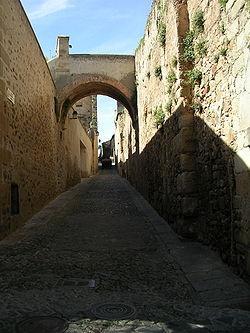Cáceres, Extremadura, Spain
Suggest Place to Visit
3231
Track to location with GPS |
 |
Prehistory [edit]
Cave of Santa Ana.
Maltravieso Cave.
The first human presence in the territory of what is today Cáceres dates back to Prehistory. In the Calerizo area there are several caves, such as the Santa Ana Cave, which has the oldest human presence in Extremadura, around 1 million years old, the Cave of El Conejar and Maltravieso (discovered in 1956 by the academic and official chronicler of Cáceres Carlos Callejo) where pictorial vestiges of human hands have been found, with the particularity that they have the little finger hidden under a layer of paint (in the past it was thought that they were amputations). The dating of these paintings includes various stages of the Upper Paleolithic. In the nearby cave of El Conejar, some ceramics and lithic utensils have been found that date the occupation of the cave in the Ancient Neolithic (VI-V millennium BC), nor should we rule out the possibility that it was occupied during the Epipaleolithic. Later, some trepanned skulls and decorated ceramics suggest that the Maltravieso cave was also occupied during the Bronze Age.
Roman domain [edit]
Aerial view of the Roman camp origin of Cáceres, with the EX-390 road diverted from its old route so as not to affect it.
Main article: Norba Caesarina
However, it was in the 1st century BC. C. when the Romans settled in camps (Castra Cecilia and Castra Servilia) permanently in the surroundings of the hill where the Norba Caesarina colony would be next to the important communication route that later would be known as Vía de la Plata.
Around the 5th century AD. C. the Visigoths devastate the establishment and until century VIII-IX the city is not heard of again.
2 km to the SE is the old municipality of Aldea Moret, currently a neighborhood of the same name integrated into the city, around which two Roman archaeological sites can be seen: ´´Cuarto Roble and ´´El Junquillo´´. The Vía de la Plata, signposted, can be traversed to the south of the city: a section runs not far from the ´´Mobilization and Instruction Center´´ (CIMOV) Santa Ana heading south; there is a section excavated in Valdesalor, where the road crosses the river Salor by means of a recently restored medieval bridge, which occupies the place of an old Roman bridge, now lost.
Arab domain [edit]
Adarve de La Estrella in the Monumental City.
It was the Muslims, from North Africa, who took advantage of the strategic place on which the primitive Roman colony settled as a military base to face the Christian kingdoms of the north, during the first centuries of the Reconquest. From the Arabic comes the current name of Vía de la Plata, the name of the Roman road that linked Astorga with Andalusia (from the Arabic balata, calzada, from which the word ´´plata´´ derived -by corruption-).
In the 12th century, before the Christian advance, the city was fortified with an adobe wall (which is still preserved), a fact that was not enough to prevent Alfonso IX, monarch of the kingdom of León, from taking the city after several years of siege on April 23, 1229, Saint George's Day, granting the city the Fuero de Villa, which since then is celebrated in the city as its patron. Previously, another attempt had been made to take it by Ferdinand II in 1169, who was able to regain the square for Christians for 5 years, falling back into Muslim hands in 1174.
Cáceres was from then on a free Villa, not of lordship, its neighbors being able to choose their 12 Regidores; It was immediately repopulated by Leonese, Asturians, Galicians and Castilians, although over time its inhabitants divided into two camps: that of the Leonese (which would also include the original peoples of Galicia and Asturias), and that of the Castilians. The former inhabited the upper part of the city (San Mateo neighborhood), and the latter in the lower part (Santa María neighborhood) .The nobles of the Leonese and Castilian sides frequently clashed violently, and the situation reached such extremes , that Cáceres had in practice two different councils that did not stop fighting. The situation lasted until the arrival of Isabel the Catholic who decided to pacify the situation, and drew up new ordinances. The Villa became in 1477 Realengo and her perpetual Regidores; Very Noble and Very Loyal Villa.
From that moment on, Cáceres began to transform itself, building churches in the place of mosques and Christian palaces on the primitive Muslim palaces, although it was the fortunes from America that contributed the most to the monumentality of the city, and to whom Leopoldo Alas (Clarín ) called ´´La Vetusta del Sur´´.
With slight adjustments until the 18th century, this version is the one that has survived to this day.
Cáceres is a city in western Spain, capital of the homonymous province. It is located in the central area of the ancient Roman province of Lusitania, in the autonomous community of Extremadura. With 93,131 inhabitants (INE 2009), it is the largest and most populated city in the province, accumulating 22.51% of the total population of the same. It is also the largest municipality in Spain with an area of 1,750.33 km².
The city of Cáceres was declared a World Heritage Site by Unesco in 1986, as it has one of the most complete urban complexes from the Middle Ages and the Renaissance in the world. The Cathedral of Santa María, the Palacio de las Veletas (Archaeological Museum), the palaces of Los Golfines (Up and Down), the Casa del Sol, the Tower of Bujaco or the Arco de la Estrella are the most beautiful and admirable monuments. . Likewise, it stands out for being the headquarters of one of the four campuses that the University of Extremadura has and for its dynamic cultural life throughout the autonomous community. It aspires to be the European Capital of Culture in 2016.
Economy
It is the main commercial, administrative and economic hub of the province and, with 660,668 visitors registered by the municipal tourist centers in 2009, the first tourist center in the region. Its economy is based mainly on the tertiary sector (services), tourism and construction, with a limited contribution from the industrial sector focused on food, textile, ceramics and rubber products. In the city there are 3 industrial estates in which a large number of companies are based. Although in the past it had several mines in operation (such as Valdeflores and the five in Aldea Moret), at present all are closed; However, there are two quarries located on the outskirts of the city.
The Cáceres area of commercial influence is ranked second in the region with 251,631 inhabitants, according to the 2008 Economic Yearbook of Spain, published by the La Caixa Research Department. This figure is the one that results from adding the population of the capital (92,187), that of the closest municipalities (57,878) and that of others further away but that have the city as a benchmark from a commercial point of view (101,566).
Provisional population data by municipal districts as of January 1, 2009
Center: 27,668 inhabitants.
West (new): 15,770 inhabitants.
South: 14,283 inhabitants.
Mejostilla: 10,416 inhabitants.
Aldea Moret: 6,786 inhabitants
Old town: 5,836 inhabitants.
West: 4,693 inhabitants.
North: 4,652 inhabitants.
East: 2,647 inhabitants.
Other areas: 1,949 inhabitants.
Pedanías (Rincón de Ballesteros, Valdesalor and Estación Arroyo-Malpartida): 767 inhabitants.
Rest: 306 inhabitants.
Weather
It is of a continental type, softened by the proximity of the Atlantic Ocean: the average temperature in winter does not exceed a maximum of 10 ° C, reaching a minimum of -5 ° C, with some frosts. In summer the average temperature is 35 ° C maximum and 20 ° C minimum. Rainfall is abundant in the months of October, November, March, April and May, but very intermittent.
Science
Astronomy
Astronomical Observatory of Cáceres, privately managed, located in the nearby Aldea Moret, dedicated to performing CCD Photometry in Band V, Band R and as of 2008 Spectroscopy.
Astronomical Observatory of the Integrated Education Center (CEI) available to its students.
Astronomical Observatory located on the Campus of the University of Extremadura, works in a network with the observatory installed on the Campus of Badajoz.
Although in 2008 a project for the construction of a public astronomical observatory, located in the Mountain, was presented to the Consortium ´´Cáceres 2016´´, said project was denied in April of the same year.
Meteorology
Meteorological Observatory (Carretera de Trujillo s / n) Phone: 927 181130
The average temperature of Cáceres is 16.1 ° C, reaching the maximum in July with 25.8 ° C and the minimum in January with 7.9 ° C (average obtained between the years 1971-2000)
The irradiation value (number of hours of sunshine) is 2890 per year, with the maximum being during the month of July (370 hours / month) and the minimum in December (123 hours / month)
The average annual rainfall is 523 mm, reaching the maximum in December (87 mm) and the minimum in July (7 mm)
Education
college
The Cáceres University Campus is part of the University of Extremadura, and is located on the N-521, direction Cáceres to Trujillo. Here, degrees in Law, Veterinary Medicine, Nursing, Sports, Computer Science, Telecommunications, Education, Philosophy and Literature, Geography and Spatial Planning, History, Architecture and Public Works are taught.
places
Main Square
Forum of the Balbos
St. George Square
Jewish Quarter
Roman camp ´´Cáceres el Viejo´´ (Torrejón el Rubio road). Roman camp from the republican era that housed two legions, it has a rectangular shape, 680 meters long by 400 meters wide, slate walls mixed with mud, with a double moat and four gates.
Possibly called ´´Castra Servilia´´, for being the camp of Servilio Cepión during the Portuguese wars. Cited by Plinio together with the ´´Castra Caecilia´´ camp, with which it merged in 35 BC to form the Roman Colony of ´´Norba Caesarina´´, current Monumental Cáceres.
Fragment of Roman wall (Plaza del Socorro)
Medieval cistern of the Wells Tower
Palace of the Audience. Since 1790 it has been the seat of the Royal Court of Extremadura and the current Palace of Justice.
Castles of the Arguijuela de Abajo and de Arriba: These castles are located a few kilometers from the city, on the N-630 road towards Mérida
Town Hall building, located in the Plaza Mayor. Begun in 1867 and inaugurated two years later.
Bullring: Built in 1846, one of the oldest in Spain and best preserved.
Maltravieso Cave: with hand paintings of about 22,000 years old, with animal bones and lithic tools from 350,000 years ago.
Other areas of interest
Mirador de la Ermita de la Montaña with a privileged view of the city and its surroundings.
Cold source (after the slopes of the San Francisco residential area), a natural spring from which many people from Cáceres get their water.
Calle Pintores, Moret and Roso de Luna (typical commercial)
Plaza de Antonio Canales (old Plaza de Italia, with its tower erected in 1929)
Mercado Franco (located on Wednesdays in Ronda de la Pizarra, where it is possible to find typical foods of the province)
Paseo de Cánovas, Parque del Príncipe and Parque del rodeo, the latter with an artificial lake inside.
Culture
Local parties
Semana Santa Cacereña, (of National Tourist Interest): some of whose brotherhoods are among the oldest in Spain. Thus that of the Nazarene and of Mercy have statutes from the year 1464, that of the Holy Spirit from the year 1493, that of the Holy and Vera Cruz from the year 1521 or that of La Soledad that dates back to 1582. During 2008, 12 brotherhoods paraded with 37 steps in 18 parades, with the participation of about 3,000 brothers. The passage called ´´del Cristo Negro´´ is one of the most revered, standing out for its austerity and seriousness. Due to its peculiarity, it aspires to be declared of International Tourist Interest.
Celebration of San Jorge (April 23): The most significant events begin on the 22 in the afternoon, with the parade and fight of Moors and Christians and the burning of the dragon in the Plaza Mayor, where the reconquest of the city by King Alfonso IX.
Pilgrimage of the Virgen de la Montaña: With this act the people of Cáceres receive their patron, who will remain in the city until the first Sunday in May, who will return to her Shrine. The Monumental City is a continuous coming and going of people who go to visit their patron who is in the Cathedral of Santa María.
Our Sª. de la Montaña -Patrona de la Ciudad- (first Sunday in May)
May Fair: Big Fair of Cáceres, coincides with the San Fernando festival. On the occasion of the festivities, concerts will be held in the Equestrian Venue.
´´Las Candelas´´ and San Blas (February 1, 2 and 3): This is one of the most popular festivals in the city. During the morning the Virgen de las Candelas leaves in procession from her hermitage of the same name, located in the heart of the Monumental City, for which the streets are decorated to receive the Virgin during her journey. The festival of San Blas takes place in its hermitage, the same day as the Candles, that is, the eve of the saint. The surroundings of the hermitage are filled with young people wearing the campuza dress and the beautiful ´´ watermelon´´ or ´´ thousand colors´´ scarf. During the afternoon of San Blas typical Extremaduran music is heard.
Pilgrimage of the Holy Martyrs San Fabián and San Sebastián (January 20): Popular celebration, which has served for the people of Cáceres to return to one of the most beautiful corners of the city for its ecological value, the Paseo Alto. Aniseed bagels are traditionally made and sold in the thousands during that day.
Pilgrimage of Sta. Lucía (second Sunday in May)
Music festivals
WOMAD, in May: Well-known festival organized by the world organization WOMAD -World Of Music, Arts and Dance- and created by Peter Gabriel, in 1982, the one held in Cáceres being the first of the two held during the year in Spain - Cáceres and Canarias- and that makes it unique among the 9 that are celebrated all over the world, as it takes place inside the monumental city, which gives it a very characteristic magical atmosphere.
Cáceres Pop-Art, in September: Festival that brings together different artistic manifestations related to pop culture, such as music, art, photography, cinema, literature, comics or fashion. Exhibitions are organized, film cycles take place in the city at the Extremadura Film Library and a series of free concerts, giving priority to emerging groups and artists who stand out in national and international independent music. It ends with the delivery of the Pop Eye awards to musicians and creators linked to non-commercial circuits.
Aldea de la Amex, in September: Festival organized by the Extremadura Musicians Association and held in the Aldea Moret neighborhood dedicated to the integration of gypsy culture through music and art.
Cáceres Irish Flead, in November: Festival of traditional Irish and Celtic music in general, with performances in pubs and theaters of the city.
West Festival, in the first week of July: Hard rock, heavy metal and national and international punk-rock groups.
International Festival of Black Music Ciudad de Cáceres, in July: Festival that unites different styles such as soul, funky, blues, disco and others.
Festival of Ancient Ibero-American Music, in September: Concerts and ancient music courses that are held in different locations and temples of the monumental city.)
International Folk Festival of the Peoples of the World, in July: with performances, parades and workshops.
Musical autumn
Other events
Cáceres Classical Theater Festival, in June.
Cáceres Spanish Cinema Solidarity Festival, in February: [6] its hallmarks are the promotion of Spanish cinema (screenings, books, magazines, workshops and conferences) and the donation of all the profits generated to different Extremadura NGOs; culminates with the delivery of the San Pancracio's Awards. Parallel to the festival, film books are published and meetings are held with short filmmakers and a workshop for directing actors, thus seeking new paths for the development of Spanish cinema through analysis and dialogue. The festival has become a benchmark on the national scene and in the cultural offer of Cáceres.
South Forum. Contemporary Ibero-American Art Fair, in April: It is held at the San Jorge Exhibition Center, in the heart of the Monumental City of Cáceres, although it also has artistic manifestations in the rest of the city. It tries to spread the knowledge of contemporary art, promote the artistic market and promote collecting. Currently, it is classified as the second most important contemporary art fair in Spain after ARCO.
Medieval Market, in November: It is interesting to visit this market that is installed within the walls; considered the second most important in Spain, in it you can buy curious, classic or handcrafted objects, typical products and food from the land, with a historical setting throughout the Monumental City. It consists of the celebration of the cultures that coexisted in Cáceres.
Extremadura Gay and Lesbian Film Festival, in November: Cáceres is one of its venues along with Mérida and Badajoz.
Festival Envideo Cáceres
Comments
We don´t have yet any comments about:
Cáceres
Cáceres
Be the first to leave a comment as it is very important to inform other people
Outros locais a visitar
Within a radius of 20 km from:Cáceres
Museo De Cáceres |
| 0,1 Km |
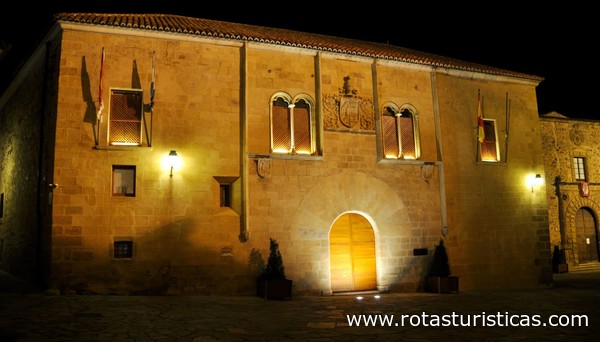 |
Centro de Artes Visuales Fundación Helga de Alvear |
| 0,2 Km |
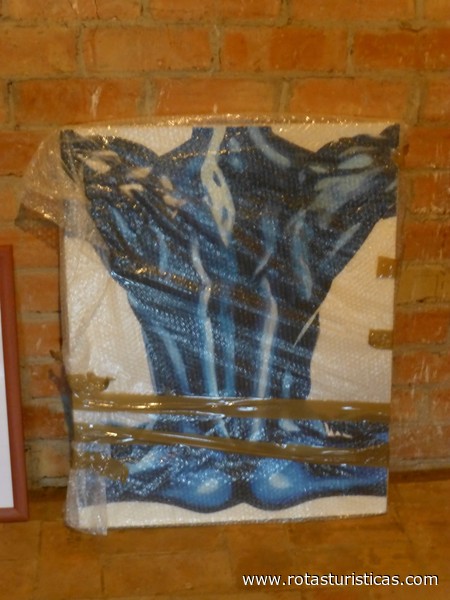 |
Museo de la Concatedral |
| 0,3 Km |
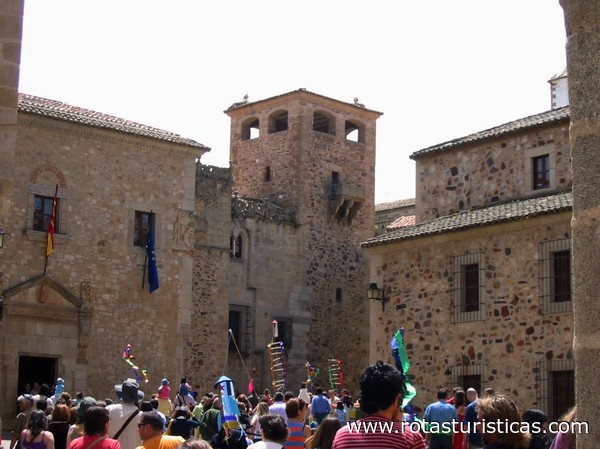 |
Santa María Cathedral |
| 0,3 Km |
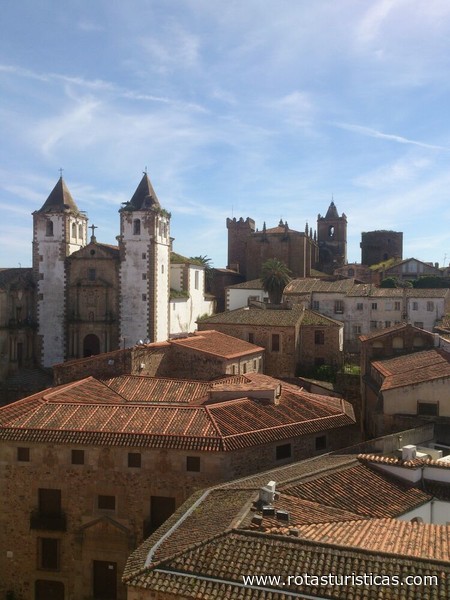 |
Hotel reservation near Cáceres within a radius of 20 km
Why to book with CLUBE TRAVEL
The best prices
Our partnerships with the world´s largest operators offer research on the best market prices.
More options
At Rotas Turisticos you can book the hotel, buy the air ticket, book the transfer from the airport to the hotel and vice versa, book the local excursions, rent the car, take travel insurance and consult the places to visit and where to go.
Holiday Tips & Destinations
Hundreds of holiday destinations with all the options that allow you to easily choose the destination that best suits your dream vacation.
CLUBE TRAVEL
Links


